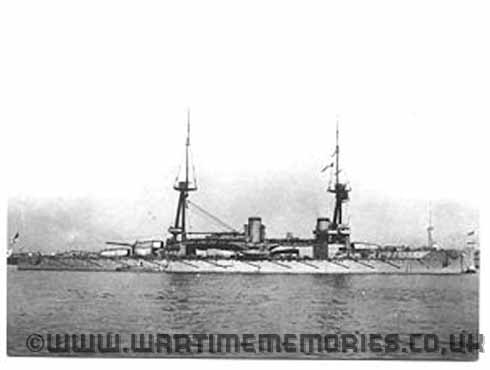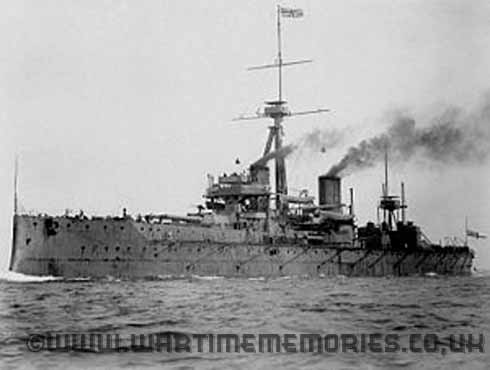
HMS Neptune
HMS Neptune was a Royal Navy dreadnought battleship, intended to be the lead ship of three Neptune-class battleships, but the subsequent two ships had slightly thicker belt armour and were reclassified as the Colossus class.
Ordered in the 1908 Naval Estimates and built by Portsmouth Dockyard.
Laid down on the 19th January 1909, Launched on the 30th September 1909 and
Commissioned on the 11th January 1911.
she had a displacement of 19,900 tons (22,000 full load), Length: 546 ft (166 m), Beam: 85 ft (26 m), Draught: 27 ft (8.2 m).
Powered by Parsons steam turbines, direct drive on four shafts, 25,000 shp, 18 Yarrow boilers, she had a top speed of 21 knots (39 km/h) and a range of 6,330 nm at 10 knots (19 km/h). Her crew complement was 756 officers and ratings.
She was armed with
10 × BL 12-inch (304.8 mm) Mk XI guns (5×2),
12 × BL 4-inch (101.6 mm) Mk VII guns and
3 × 18 inch (457 mm) torpedo tubes (later removed).
She was the first Royal Navy battleship that differed in her gun turret layout from Dreadnought. She had two wing turrets staggered en echelon so that all five turrets could shoot in broadside, although in practice the blast damage to the superstructure and boats made this impractical except in an emergency.
To achieve this staggering firepower with such a small increase in hull length, the ship was equipped with superfiring rear turrets; arranged so that one would fire over the other when shooting towards the stern. She was the first Royal Navy ship to have a superfiring main armament. However, the upper of the two turrets could not fire within 30 degrees of the stern without the lower turret being damaged by blast through its sighting hoods.
A further saving in length was achieved by siting the ship's boats on a flying deck over the two midships turrets to reduce the length of the vessel. However, had the flying deck been damaged during action, they may have fallen onto the turrets, immobilising them. The bridge was also situated above the conning tower, which risked similarly being obscured if the bridge collapsed.
She was one of the first battleships to be built with director gun-control and was used for trials of this then-novel system.
She was flagship of the Home Fleet from May 1911 until May 1912 when she was transferred to the 1st Battle Squadron, where she remained until June 1916, just after the Battle of Jutland. She was accidentally struck by SS Needvaal in April 1916 but no serious damage was done. She was present at the Battle of Jutland as part of Admiral Jellicoe's Battle Fleet. She fired only 48 12 inch (305 mm) shells but is credited with scoring several hits on the German battlecruiser Lützow. Her captain was Vivian Bernard.
After the war she was quickly transferred to the reserve fleet and subsequently scrapped in 1922.
John Doran
1st September 1914 British Battleships 
HMS Dreadnought
Name: HMS Dreadnought, Dreadnought Class Battleship.
Ordered: 1905, Builder: HM Dockyard, Portsmouth
Laid down:2 October 1905, Launched:10 February 1906.
Commissioned: 2 December 1906, Decommissioned: February 1919.
Fate: Scrapped, 1923.
Displacement: 18,120 long tons (18,410 t)
Length: 527 ft (160.6 m), Beam: 82 ft 1 in (25.0 m), Draught: 29 ft 7.5 in (9.0 m)
Installed power: 23,000 shp (17,000 kW), 18 Babcock & Wilcox water-tube boilers. Propulsion: 4 shafts, Parsons direct-drive steam turbines.
Speed: 21 knots (39 km/h; 24 mph)
Range: 6,620 nautical miles (12,260 km; 7,620 mi) at 10 knots (19 km/h; 12 mph)
Crew complement: 700,810 officers and ratings.
Arament and Armour.
- Armament:
- 5 × twin BL 12-inch Mark X guns
- 27 × single 12-pdr 18 cwt Mark I guns
- 5 × 18-inch (450 mm) torpedo tubes
- Armour:
- Belt: 4,11 in (102,279 mm)
- Deck: 0.75,3 in (19,76 mm)
- Barbettes: 4,11 in (102,279 mm)
- Turrets: 3,12 in (76,305 mm)
- Conning tower: 11 in (279 mm)
- Bulkheads: 8 in (203 mm)
HMS Dreadnought was a battleship of the Royal Navy that revolutionised naval power. Her entry into service in 1906 represented such a marked advance in naval technology that her name came to be associated with an entire generation of battleships, the "dreadnoughts", as well as the class of ships named after her. The generation of ships she made obsolete became known as "pre-dreadnoughts". She was the sixth ship of that name in the Royal Navy.
Admiral Sir John "Jacky" Fisher, First Sea Lord of the Board of Admiralty, is credited as the father of the Dreadnought. Shortly after he assumed office he ordered design studies for a battleship armed solely with 12-inch (305 mm) guns and a speed of 21 knots (39 km/h; 24 mph). He convened a "Committee on Designs" to evaluate the alternative designs and to assist in the detailed design work. One ancillary benefit of the Committee was that it would shield him and the Admiralty from political charges that they had not consulted leading experts before designing such a radically different battleship.
Dreadnought was the first battleship of her era to have a uniform main battery, rather than having a few large guns complemented by a heavy secondary battery of smaller guns. She was also the first capital ship to be powered by steam turbines, making her the fastest battleship in the world at the time of her completion. Her launch helped spark a naval arms race as navies around the world, particularly the German Imperial Navy rushed to match her in the build-up to World War I.
Dreadnought did not participate in any of World War I's naval battles as she was being refitted during the Battle of Jutland in 1916. This was the only time that British dreadnought battleships fired on their German counterparts during the war. She became the only battleship to sink a submarine when she rammed the SM U-29 when it unexpectedly broke the surface after firing a torpedo at another dreadnought in 1915. She was relegated to coastal defence duties in the English Channel after Jutland, only rejoining the Grand Fleet in 1918. She was reduced to reserve in 1919 and sold for scrap two years later.
Dreadnought became flagship of the 4th Battle Squadron in December 1912 after her transfer from the 1st Battle Squadron, as the 1st Division had been renamed earlier in the year. Between September and December 1913 she was training in the Mediterranean Sea. At the outbreak of World War I in 1914, she was flagship of the 4th Battle Squadron in the North Sea, based at Scapa Flow. She was relieved as flagship on 10 December by HMS Benbow.
Ironically for a vessel designed to engage enemy battleships, her only significant action was the ramming and sinking of German submarine SM U-29, skippered by K/Lt Otto Weddigen (of SM U-9 fame), on 18 March 1915. U-29 had broken the surface immediately ahead of Dreadnought after firing a torpedo at HMS Neptune and Dreadnought cut the submarine in two after a short chase. She almost collided with HMS Temeraire who was also attempting to ram. Dreadnought thus became the only battleship ever to sink a submarine.
John Doran
If you can provide any additional information, please add it here.







